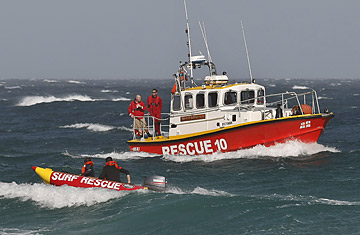
National Sea Rescue Institute vessels search for the remains of a shark-attack victim off Fish Hoek beach in Cape Town, South Africa, on Jan. 12, 2010
The thing about last week's deadly great-white shark attack, just south of Cape Town and about 15 minutes' drive from my house, is that everyone knows the sharks are there. We've been warned many times — not least by the annual shark attacks that happen up and down South Africa's lengthy coastline. We also know that the warm waters of False Bay, south of the city, are a favored breeding and feeding ground for great whites, particularly around Seal Island, a rock that sits in the middle of the bay and hosts a huge colony of Cape fur seals. And we're well aware that Fish Hoek, the seaside holiday village where the attack took place, is particularly dangerous. Many of us have seen this picture, taken just off our favorite beach. And if anyone doubted just how deadly these waters can be, on Nov. 15, 2004, a great white made off with Tyna Webb, a 77-year-old widow taking her morning dip. That attack, like the one that killed 37-year-old Zimbabwean Loyd Skinner on Jan. 12, was watched by helpless shark spotters sitting with their binoculars on a mountainside above the beach.
So why, you might ask, did I take my wife and two daughters, along with our two friends from Britain and their two daughters and baby son, to Fish Hoek for a swim just four days before the latest attack? For that matter, why did much of Cape Town? (We didn't arrive until midday, and by then the beach was so full we had to lay out our towels on some concrete steps.) It wasn't that we'd forgotten about the sharks. As we set up our little beach camp, I regaled our guests with a story about the legendary "Sub," a monstrous great white that, as some accounts have it, lived in False Bay in the 1970s and '80s. Sub was said to show up on sonar and enjoy munching outboards off the back of motorboats. Our fellow swimmers were likely just as mindful of the predators in the water: many were nipping off for lunch at a place called Kalkies, a nearby fish-and-chips shop decorated with poster-size photographs of great whites leaping out of the water, often with a seal in their jaws.
So: We know. And we still go. Worse, we take our children — even our friends' children. What kind of maniacs are we? Answer: We're incorrigible gamblers. Addicts, to judge by the frequency with which we go. But judge for yourself whether you think we're being reckless with the odds we're playing with. The chances of being attacked by a shark while swimming in the ocean, according to the International Shark Attack File at the Florida Museum of Natural History, are 1 in 11.5 million. The chances of a fatal attack are 1 in 264.1 million. Both odds decrease somewhat if you are bleeding or, it turns out, peeing. By comparison, the chances of drowning during a visit to the beach are just 1 in 2 million. And the chances of being struck by lightning in any given year are 1 in 500,000, according to the National Weather Service — a risk that narrows to 1 in 6,250 over an 80-year lifetime. Four people died in shark attacks in the U.S. from 2004 to '08; during the same period, the National Weather Service estimates, 2,700 Americans were struck by lightning.
Those figures may make shark attacks sound pretty unlikely, but remember, those are the chances of being attacked in any of the oceans of the world, rather than in my local, great white–infested bay.
What convinces me that my local beach is safe is the truth about the Sub. The monster of the deep was, I'm sorry to report, a myth dreamed up in the 1970s over several pints at the Tavern of the Seas by a group of bored Cape Town news reporters keen to test the gullibility of their readers. The experiment succeeded beyond their wildest expectations. From the moment they ran they story, the papers were inundated with reports of sightings from readers, and the Sub became its own living myth. Cape Town newspapers ran stories about the apocryphal beast well into the late 1980s. Since poor Mr. Skinner's death, the papers and police have been swamped with calls — all false — about body parts washing up on the beach. The point is this: a shark attack teaches us something about the nature of sharks, or at least the nature of a shark — but it teaches us far more about human nature.
